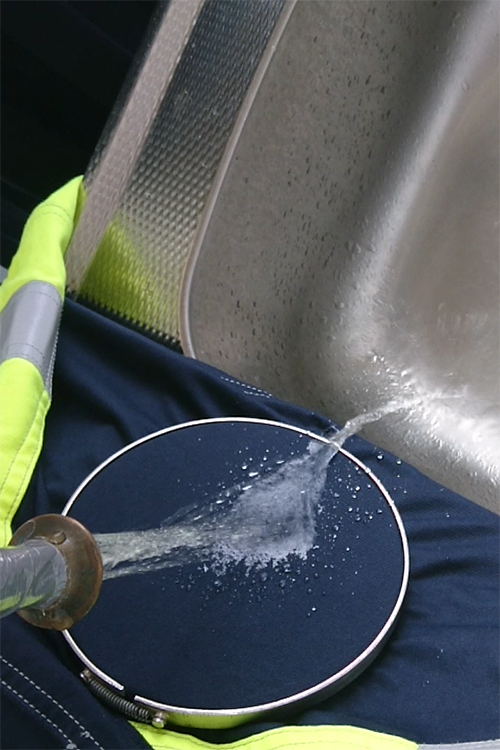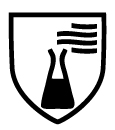
CHEMICALS
EN 13034 Type PB [6]
Protective clothing against liquid chemicals
This standard specifies PPE Clothing used where there is a risk of a potential exposure to a light spray, liquid aerosols or low pressure, low volume splashes when complete liquid permeation barrier (at a molecular level) is not required.
In accordance to the standard EN 13034 the following chemical groups/chemicals can be tested:
| Chemical group | Chemical |
| Acid | H2SO4 30% (Sulphuric acid) |
| Alcaline | NaOH 10% (Sodium hydroxide also called lye and caustic soda) |
| Aromatic Hydrocarbon | O-xylene |
| Alcohol | Butanol |

The result is given in scale 1-3 where the maximum value is 3. To pass the test and be able to use the EN 13034 symbol in the CE-marking, at least one chemical shall obtain level 3 for liquid repellency and at least one chemical shall obtain level 2 for resistance to penetration. The design of the garment is also a parameter in the CE marking for chemical protection garments.
| Test result for fabric (class) | 885 Cantex Weld PFAS-free | 884 Cantex Stretch PFAS-free | 882,883 Cantex 2.0 | 931 Cantex 240IR | 811 Tera TX | 812 Tera TX TW | 863 Outback HW PFAS-free | 862 Outback 250 | 943 Mega TX 230IR | 846 Ara TX | 955 Windtech FR550 | 950 Windtech FR340 | 830 Apex | 821 PFAS-free | |
| The material's ability to repel chemicals | |||||||||||||||
| Acid | H2SO4(30%) | 3 | 3 | 3 | 3 | 3 | 3 | 3 | 3 | 3 | 3 | 3 | 3 | 3 | 3 |
| Alcaline | NaOH (10%) | 3 | 3 | 3 | 3 | 3 | 3 | 3 | 3 | 3 | 3 | 3 | 3 | 3 | 3 |
| Aromatic Hydrocarbon | O-xylene | - | - | - | - | - | - | - | - | - | - | - | - | 2 | - |
| Alcohol | Butanol | - | - | - | - | - | - | - | - | - | - | - | - | 2 | - |
The material's ability to resist penetration by chemicals | |||||||||||||||
| Acid | H2SO4(30%) | 3 | 3 | 3 | 3 | 3 | 3 | 3 | 3 | 3 | 3 | 3 | 3 | 3 | 3 |
| Alcaline | NaOH (10%) | 3 | 3 | 3 | 3 | 3 | 3 | 3 | 3 | 3 | 3 | 3 | 3 | 3 | 3 |
| Aromatic Hydrocarbon | O-xylene | - | - | - | - | - | - | - | - | - | - | - | - | 3 | - |
| Alcohol | Butanol | - | - | - | - | - | - | - | - | - | - | - | - | 3 | - |
”-” Chmical group/chemical not tested/does not pass the test.
If your company only requires protection against acid or alcaline, you can advantageously choose a fabric with a PFAS-free finish. A PFAS-free finish does not contain the flourine-carbon bod, that is very difficult for nature to break down, making the product a better and more enviromentally friendly choice. If your company instead requires protection against O-xylene or butanol, you need a fabric with a PFAS finish. Contact Tranemo if you are not sure which protection your company needs.
When you choose garments with chemical protection (EN 13034), it is important that you check that the relevant chemical group/ groups are tested on the garment quality you choose. Not all four chemical groups will usually be relevant for your Risk Assessment. If you are working with other chemicals or other concentrations of the above chemicals, please contact us for information on the best fabric / garment solution for your Risk Assessment. To fulfill EN 13034 on Tranemo product range, Tranemo use finishing that meets the restrictions for fluorine chemicals for consumers in Norway and also for the restrictions in EU REACH. Please note that FC finish used for EN 13034 certification needs to be re-activated by heating the garment after each wash cycle. The garment must also be re-impregnated when necessary. Industrial Laundries have processes for doing this the correct way.
SUSTAINABILITY
If your company does not need protection against O-xylene or Butanol you can choose a fabric with a PFAS-free finish, Tranemo’s PFAS-free finish passes EN 13034 for acid and alkaline. A PFAS-free finish does not contain any fluorine atoms which is very difficult for nature to break down. This makes a PFAS-free product a better and more environmentally friendly choice.
Cantex Weld Stretch is Tranemo’s first collection featuring a fluorocarbon-free finish (CO) that meets the requirements of EN 13034. A fluorocarbon free finish does not contain any fluorine atoms in the molecular chain, which makes it more environmentally friendly. Fluorocarbons have long been debated as being undesirable from an environmental perspective because they are ‘persistent’ i.e extremely difficult for nature to break down. Fluorocarbon free fabrics comply with EN 13034 for acid and alkaline with excellent results and provide a repellent protection against water and water-soluble dirt. The reason why fluorocarbons are still used are their excellent ability to repel oil and oil-based chemicals, and since some industries require oil-repellent protective clothing, it is currently impossible to phase out fluorocarbons completely. In cases where repellence of oils and oil-based chemicals is not directly necessary, Tranemo sees it as a positive development as fluorocarbon free finishes are friendlier to the environment.
It is important that the protective clothing is kept clean and washed regularly to avoid dirt becoming ingrained into the fabric and posing an additional safety risk. After washing, protective clothing certified according to EN 13034 (with or without fluorocarbon finish), need to be reactivated by heat to maintain the protection according to the EN standard. If necessary, the protective clothing may need to be re-impregnated. Tranemo recommends re-impregnation using an industrial laundry that is capable of carrying out this process. For garments that have a fluorocarbon free finish, Tranemo recommends that any re-impregnation process is also fluorocarbon free.
Tranemo continuously does in-house testing on fabrics for water repellency (according to ISO 4920 spray test) and oil repellecy (according to ISO 14419). This is to ensure that the fabrics have the correct treatment.

